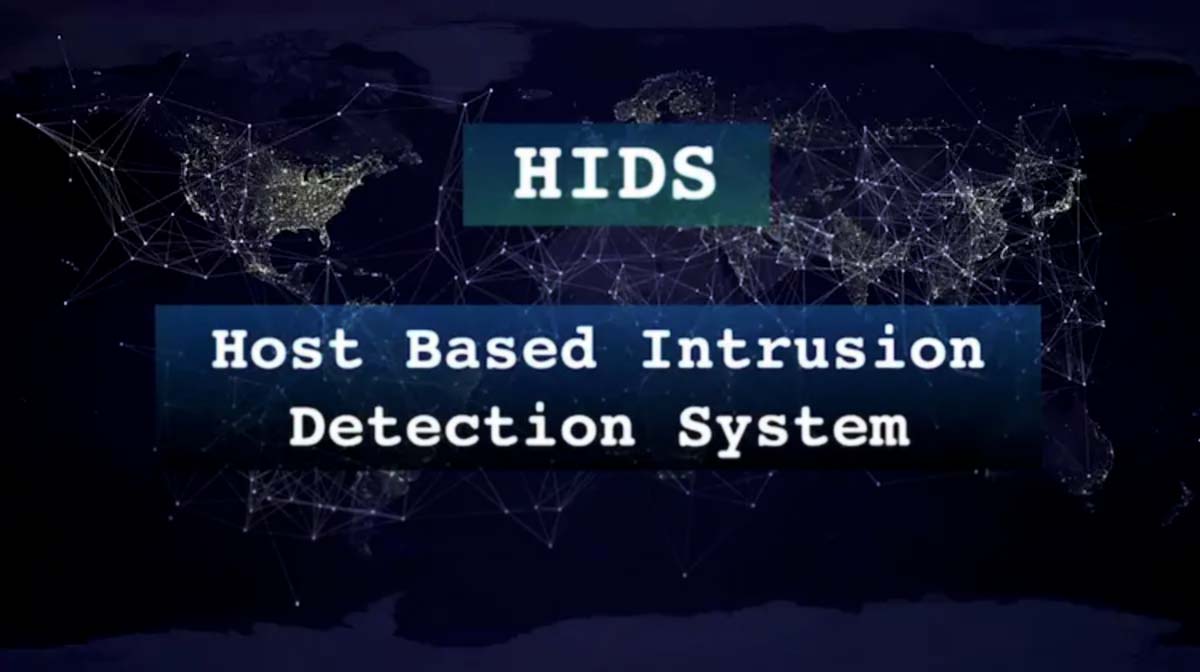Home>Home Security and Surveillance>What Role Do Intrusion Detection Systems (IDS) Serve In CISSP


Home Security and Surveillance
What Role Do Intrusion Detection Systems (IDS) Serve In CISSP
Modified: August 17, 2024
Discover the significance of Intrusion Detection Systems (IDS) in maintaining Home Security and Surveillance. Explore their role in CISSP to ensure robust protection against unauthorized access.
(Many of the links in this article redirect to a specific reviewed product. Your purchase of these products through affiliate links helps to generate commission for Storables.com, at no extra cost. Learn more)
Introduction
Welcome to the world of home security and surveillance. In today’s rapidly changing landscape, ensuring the safety and protection of our loved ones and belongings has become a top priority for homeowners. With advancements in technology, home security systems have evolved, offering a wide array of solutions to keep our homes and families secure.
One crucial component of any comprehensive home security system is an intrusion detection system, commonly known as an IDS. An IDS plays a vital role in the field of information security, providing an additional layer of defense against unauthorized access and potential threats.
In this article, we will delve into the world of IDS and explore their various types, functions, and the significant role they play in the Certified Information Systems Security Professional (CISSP) framework. Additionally, we will also highlight the benefits of IDS implementation, potential limitations, and best practices for successful deployment.
So, let’s dive in and gain a deeper understanding of the role IDS serves in home security and surveillance.
Key Takeaways:
- Intrusion Detection Systems (IDS) are like security guards for your digital home, constantly watching for suspicious activities and alerting you to potential threats, helping keep your digital environment safe and secure.
- Implementing IDS requires careful planning and continuous monitoring to ensure they are effective. By following best practices and staying updated, IDS can significantly strengthen your digital defenses against cyber threats.
Understanding Intrusion Detection Systems (IDS)
An Intrusion Detection System (IDS) is a security technology designed to monitor network traffic and systems for suspicious activities or potential security breaches. Its primary purpose is to detect and respond to unauthorized access attempts, malicious activities, and other security incidents that could compromise the integrity, confidentiality, and availability of information.
IDS works by analyzing network packets, log files, and system events to identify patterns indicative of a potential intrusion or security threat. It employs a combination of signature-based detection, anomaly detection, and behavioral analysis techniques to differentiate normal and abnormal activities within a network environment.
There are two main types of IDS – network-based and host-based. Network-based IDS monitors network traffic and analyzes packets flowing through the network. It can detect network-based attacks, such as port scans, denial-of-service (DoS) attacks, and network intrusion attempts. On the other hand, host-based IDS focuses on monitoring activities occurring on individual host systems, such as servers and workstations. It can detect anomalous behavior, suspicious file modifications, and unauthorized access attempts on specific hosts.
Furthermore, IDS can also be categorized as passive or active. Passive IDS monitors network traffic without taking any action to stop or prevent an intrusion. It provides real-time alerts to security personnel, who can then analyze and respond to the detected threats. Active IDS, on the other hand, has the ability to take automated actions to block or mitigate potential attacks. It can actively interfere with network traffic to prevent unauthorized access or halt suspicious activities.
IDS operates based on a set of predefined rules and policies, also known as signatures or signatures. These signatures are created by security experts and researchers to identify known attack patterns. Additionally, IDS also employs anomaly detection techniques, which involve establishing baselines for normal behavior and triggering alerts when deviations from the baseline are detected. This allows IDS to detect previously unseen or zero-day attacks that do not match any existing signatures.
Overall, IDS plays a critical role in providing early warning and threat detection capabilities, allowing security teams to take proactive measures to prevent and respond to security incidents effectively. Now that we have a good understanding of IDS, let’s explore their functionality in more detail.
Types of Intrusion Detection Systems
Intrusion Detection Systems (IDS) come in various types, each tailored to specific security needs and environments. Let’s explore the different types of IDS in more detail:
- Network-Based IDS (NIDS): NIDS is designed to monitor network traffic and analyze packets flowing through the network. It scans network packets in real-time, searching for patterns indicative of potential attacks or security breaches. NIDS can detect various network-based attacks, such as port scans, network intrusion attempts, and suspicious communication.
- Host-Based IDS (HIDS): HIDS focuses on monitoring activities occurring on individual host systems, such as servers and workstations. It analyzes system logs, file modifications, and user activities to detect anomalies or signs of unauthorized access. HIDS provides an additional layer of defense by monitoring activities that may go unnoticed by network-based IDS.
- Network Behavior Analysis (NBA) Systems: NBA systems use behavioral analysis techniques to detect anomalous behavior within a network. Rather than relying solely on predefined signatures, NBA systems establish baselines for normal network behavior and trigger alerts when deviations are detected. This helps in detecting previously unseen or zero-day attacks that may not be identified by signature-based IDS.
- Application-Level IDS (ALIDS): ALIDS specializes in monitoring application-layer protocols and detects attacks that target specific applications or services. It analyzes communication patterns and investigates traffic at the application layer to identify potential security issues. ALIDS is particularly effective in detecting attacks like SQL injection, cross-site scripting (XSS), and other web application vulnerabilities.
- Wireless IDS (WIDS): As the name suggests, WIDS is designed to secure wireless networks and detect potential threats in wireless communication. It monitors wireless network traffic for unauthorized devices, rogue access points, and suspicious activities. WIDS helps in ensuring the security of wireless networks and preventing unauthorized access to sensitive information.
It’s important to note that organizations often deploy a combination of these IDS types to achieve comprehensive security coverage. By leveraging multiple IDS technologies, organizations can enhance their ability to detect and respond to various types of threats across different layers of their network infrastructure.
Now that we have explored the different types of IDS, let’s move on to understanding the functionality of these systems.
Functionality of Intrusion Detection Systems
Intrusion Detection Systems (IDS) perform a range of functions to ensure the security of a network or system. Let’s delve into the various functionalities offered by IDS:
- Real-time Monitoring: IDS continuously monitor network traffic, system logs, and events in real-time. This allows them to quickly detect and respond to potential security threats as they occur, minimizing the impact of attacks and reducing the likelihood of successful intrusions.
- Alert Generation: IDS generate alerts when suspicious activities or anomalies are detected. These alerts provide security personnel with critical information about the nature of the threat, affected resources, and potential mitigation strategies. Alerts can be sent via email, SMS, or through a security management console.
- Threat Identification and Classification: IDS analyze network traffic and system events, comparing them against known attack patterns and behavior baselines. This enables them to identify and classify different types of threats, such as malware infections, intrusion attempts, unauthorized access, or abnormal behavior. By categorizing threats, IDS can help security teams prioritize and focus their efforts on the most critical risks.
- Logging and Reporting: IDS maintain detailed logs of network activities, events, and detected threats. These logs serve as a valuable source of information for forensic analysis, incident response, and compliance purposes. IDS generate comprehensive reports that provide an overview of security incidents, trends, and system vulnerabilities.
- Response and Mitigation: Depending on the type of IDS deployed, they can take automated actions to respond to detected threats. This may include blocking network traffic from suspicious sources, shutting down specific services or processes, or alerting other security systems to initiate countermeasures. The ability of IDS to provide automated response and mitigation helps in reducing the response time to incidents and limiting the potential damage caused by intrusions.
- Integration with Security Infrastructure: IDS can integrate with other security technologies and systems, such as firewalls, antivirus software, and Security Information and Event Management (SIEM) tools. This allows for a more comprehensive and coordinated approach to security, where multiple systems work together to provide enhanced protection and threat intelligence.
The functionality of IDS is crucial for maintaining the security and integrity of networks and systems. By continuously monitoring and analyzing network traffic and system events, IDS provide organizations with valuable insights into potential security risks, enabling swift response and proactive measures to prevent successful intrusions.
Next, let’s explore the significant role of Intrusion Detection Systems (IDS) in the Certified Information Systems Security Professional (CISSP) framework.
Role of Intrusion Detection Systems in CISSP
The Certified Information Systems Security Professional (CISSP) is a globally recognized certification for information security professionals. It covers a wide range of domains related to cybersecurity, including intrusion detection and prevention. Intrusion Detection Systems (IDS) play a vital role in the CISSP framework, contributing to the overall security posture of organizations. Let’s explore the role of IDS in the CISSP framework:
- Threat Detection and Incident Response: IDS are essential for threat detection and incident response, which are key components of CISSP. IDS help identify and classify security threats, including unauthorized access attempts, malware infections, and suspicious network activities. This information is crucial for promptly responding to security incidents, mitigating the impact, and preventing further damage.
- Risk Management and Vulnerability Assessment: IDS assist in conducting risk management and vulnerability assessments, another critical aspect of CISSP. By monitoring network traffic and system events, IDS can identify vulnerabilities and potential risks to the organization’s infrastructure. This information can then be used to prioritize and implement appropriate security controls to mitigate the identified risks.
- Compliance and Regulatory Requirements: CISSP emphasizes the importance of compliance with security regulations and industry standards. IDS help organizations meet these requirements by monitoring network activity and generating logs and reports. These logs and reports can be used to demonstrate compliance during audits and ensure adherence to relevant regulations, such as the General Data Protection Regulation (GDPR) or the Payment Card Industry Data Security Standard (PCI DSS).
- Security Operations and Incident Management: IDS play a crucial role in security operations and incident management, which are integral parts of the CISSP framework. IDS provide alerts and notifications when security incidents occur, enabling security teams to investigate and respond promptly. IDS logs and reports also serve as invaluable resources during incident management, aiding in incident analysis, containment, eradication, and recovery.
- Continuous Monitoring and Improvement: CISSP emphasizes the need for continuous monitoring and improvement of security systems and processes. IDS play a significant role in this regard by providing continuous visibility into network activities, ongoing threat detection, and system performance. By analyzing IDS logs and reports, organizations can identify areas for improvement, update security policies, and implement necessary security controls to enhance their overall security posture.
In summary, IDS are instrumental in various domains of the CISSP framework, including threat detection, incident response, risk management, compliance, security operations, and continuous improvement. By implementing and effectively utilizing IDS, organizations can strengthen their security defenses, proactively detect and respond to security threats, and ensure compliance with industry standards and regulations.
Now, let’s explore the benefits and limitations of Intrusion Detection Systems.
An Intrusion Detection System (IDS) serves as a security tool that monitors network traffic for suspicious activity or potential security breaches. It can help identify and respond to unauthorized access or attacks on a system.
Benefits and Limitations of Intrusion Detection Systems
Intrusion Detection Systems (IDS) offer numerous benefits in enhancing the security of networks and systems. However, they also come with certain limitations. Let’s explore the benefits and limitations of IDS in detail:
Benefits of Intrusion Detection Systems:
- Early Threat Detection: IDS provide early detection of potential security threats, allowing organizations to respond quickly and mitigate the impact of attacks. By monitoring network traffic and system events in real-time, IDS can identify suspicious activities, unauthorized access attempts, and other signs of intrusions.
- Enhanced Incident Response: IDS generate alerts and notifications when security incidents occur, equipping security teams with valuable information for incident response. This enables organizations to minimize the time for incident detection, investigation, containment, and recovery, reducing the potential damage caused by intrusions.
- Improved Compliance: IDS help organizations meet compliance requirements by monitoring network activities and generating logs and reports. These logs and reports provide evidence of security controls and can support compliance with regulations and industry standards, ensuring that organizations adhere to legal and regulatory obligations.
- Reduced Downtime: IDS can help prevent service disruptions and minimize system downtime. By promptly detecting and responding to security threats, organizations can prevent successful intrusions and minimize the impact on network availability and operations.
- Enhanced Visibility and Monitoring: IDS provide organizations with increased visibility into network activities, system events, and potential security risks. This allows for better monitoring and management of the network, enabling proactive measures to address vulnerabilities and potential threats.
- Continuous Security Monitoring: IDS offer continuous monitoring capabilities, enabling organizations to have real-time visibility into ongoing network activities. This helps in identifying and responding to emerging threats, ensuring that security defenses are always up-to-date and effective.
Limitations of Intrusion Detection Systems:
- False Positives and False Negatives: IDS may generate false positive alerts, indicating a threat where none exists, or false negative alerts, failing to detect actual security incidents. These inaccuracies can lead to wasted time and resources or missed opportunities to prevent intrusions.
- Inability to Detect Advanced Threats: IDS may struggle to detect advanced and sophisticated threats, such as zero-day exploits or stealthy attacks that bypass traditional signature-based detection methods. These types of threats require advanced threat intelligence and additional security measures beyond what IDS can provide.
- Complexity and Resource Intensiveness: Deploying and managing IDS can be complex and resource-intensive. It requires expertise in configuring and fine-tuning the system, monitoring and analyzing logs and alerts, and staying abreast of evolving threats. Organizations need dedicated resources and skilled personnel to effectively implement and maintain IDS.
- Network Performance Impact: IDS may introduce overhead and impact network performance, especially in environments with high network traffic. The analysis of network traffic and packet inspection can consume resources and potentially cause network latency if not properly managed.
- Limited Protection Against Insider Threats: IDS primarily focus on external threats and may have limitations in detecting and preventing malicious activities from within the organization. Insider threats, such as unauthorized access by employees or contractors, may require additional security measures beyond the scope of IDS.
- Constant Evolution of Threats: IDS need to continually adapt to new and evolving threats. This requires regular updates and maintenance to ensure they can effectively detect and respond to the latest attack techniques. Failure to keep IDS up-to-date might render them less effective against emerging threats.
Despite these limitations, IDS continue to be a valuable component of a comprehensive security strategy. By understanding the benefits and limitations, organizations can maximize the effectiveness of IDS while complementing them with other security measures to ensure a robust defense against cyber threats.
Next, let’s explore best practices for implementing Intrusion Detection Systems.
Best Practices for Implementing Intrusion Detection Systems
Implementing Intrusion Detection Systems (IDS) requires careful planning and execution to ensure their effectiveness. Here are some best practices to consider when implementing IDS:
- Define Clear Objectives: Clearly define the objectives and goals of implementing IDS within your organization. Determine what you want to achieve, whether it’s threat detection and incident response, compliance, or risk management. This will help guide your implementation strategy and ensure that IDS align with your organization’s security needs.
- Perform Risk Assessment: Conduct a thorough risk assessment to identify the assets and vulnerabilities within your network. This will help determine the areas where IDS deployment would be most effective. Prioritize your risks and focus on protecting critical assets with appropriate IDS coverage.
- Choose the Right IDS Solution: Select an IDS solution that aligns with your organization’s needs and requirements. Consider factors such as scalability, flexibility, integration capabilities, and vendor support. Depending on your environment and objectives, you may opt for network-based IDS, host-based IDS, or a combination of both.
- Plan Network Segmentation: Implement proper network segmentation to isolate critical assets and create security zones. This helps in reducing the attack surface and containing the impact of intrusions. Place IDS strategically in these segmented networks to effectively monitor and detect threats.
- Develop Effective Signature and Rule Sets: Fine-tune the signature and rule sets of your IDS to match the specific needs and characteristics of your organization. Regularly update these sets to ensure that you can detect the latest threats and evolving attack techniques. Balance the sensitivity of the IDS to avoid generating excessive false positives.
- Establish Incident Response Procedures: Define clear incident response procedures that outline how to handle IDS alerts and security incidents. Establish roles and responsibilities, define escalation paths, and conduct regular training and drills to ensure that your team is prepared to respond effectively to security incidents identified by IDS.
- Monitor and Analyze Logs: Regularly monitor and analyze IDS logs and alerts. Develop a centralized logging and analysis system to streamline the process and facilitate efficient incident response and forensic analysis. Utilize security information and event management (SIEM) tools to consolidate and correlate data from multiple sources.
- Stay Up-to-Date: Keep your IDS solution up-to-date with the latest patches, signatures, and firmware updates. Subscribe to security alerts and advisories from trusted sources and stay informed about the evolving threat landscape. Regularly review and update your IDS deployment as your network infrastructure and security needs evolve.
- Continuous Monitoring and Testing: Continuously monitor and test the effectiveness of your IDS. Conduct regular penetration tests, vulnerability assessments, and intrusion detection system audits to identify weaknesses and improve the overall security posture. Consider leveraging threat intelligence feeds to enhance the capabilities of your IDS.
- Implement Defense-in-Depth: IDS should be part of a comprehensive defense-in-depth strategy. Combine IDS with other security controls, such as firewalls, antivirus software, access controls, and employee awareness training. Layering multiple security measures will provide a more robust and layered defense against cyber threats.
Implementing IDS requires a combination of technical expertise, thorough planning, and a holistic approach to security. By following these best practices, you can maximize the effectiveness of IDS and ensure that they contribute significantly to your organization’s overall cybersecurity strategy.
Now, let’s conclude our exploration of Intrusion Detection Systems.
Read more: What Is Wireless Intrusion Detection
Conclusion
Intrusion Detection Systems (IDS) play a critical role in home security and surveillance, providing an additional layer of defense against intrusions and potential threats. We have explored various aspects of IDS, including their types, functionality, role in the CISSP framework, benefits, limitations, and best practices for implementation.
By understanding the different types of IDS, such as network-based IDS and host-based IDS, organizations can choose the most suitable solution for their specific security needs. IDS offer functionalities such as real-time monitoring, alert generation, threat identification, logging, and response capabilities, improving the overall security posture.
In the CISSP framework, IDS contribute to threat detection, incident response, risk management, compliance, security operations, and continuous improvement. They assist organizations in meeting regulatory requirements, enhancing incident response capabilities, and minimizing the impact of security incidents.
While IDS offer numerous benefits, they also have limitations, including false positives, false negatives, inability to detect advanced threats, and resource intensiveness. However, these limitations can be mitigated through proper configuration, ongoing monitoring, and integrating IDS with other security measures.
Implementing IDS requires careful planning and adherence to best practices. Defining clear objectives, conducting a risk assessment, selecting the right IDS solution, establishing incident response procedures, and regularly monitoring and updating the system are crucial steps for successful implementation.
In conclusion, IDS are invaluable tools in the fight against cyber threats, providing early detection, enhanced incident response, compliance support, and continuous monitoring. By incorporating IDS into a comprehensive security strategy and following best practices, organizations can significantly strengthen their defenses, protect critical assets, and safeguard against potential security breaches.
Remember, security is an ongoing process, and IDS should be regularly monitored, evaluated, and updated to keep pace with evolving threats and organizational needs.
So, let’s embrace the power of IDS and ensure the safety and security of our homes and digital environments.
Frequently Asked Questions about What Role Do Intrusion Detection Systems (IDS) Serve In CISSP
Was this page helpful?
At Storables.com, we guarantee accurate and reliable information. Our content, validated by Expert Board Contributors, is crafted following stringent Editorial Policies. We're committed to providing you with well-researched, expert-backed insights for all your informational needs.













